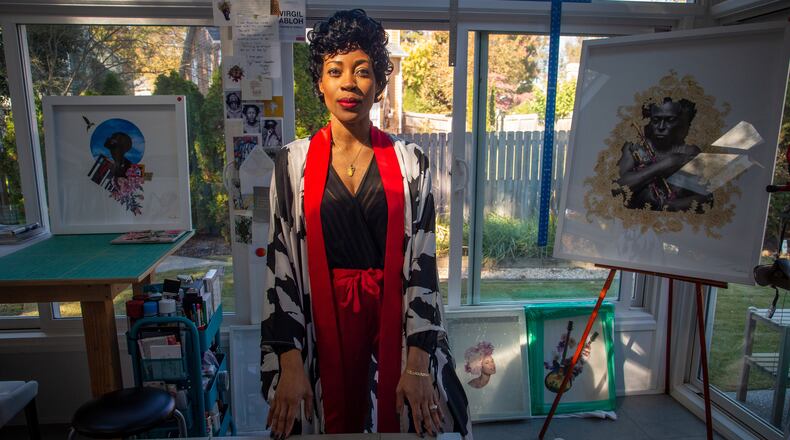In the image, Mahalia Jackson is wailing into a microphone, singing about the trouble of the world.
From her head, flowers spring forth and sprout with as much color and force the legendary gospel singer’s voice carried in each song.
Credit: Marryam Moma
Credit: Marryam Moma
In another, Atlanta’s skyline is set against the sky at dusk as headlights and tail lights blur on freeways below. But the scene is presented not as a landscape, but as a living, breathing T-shirt revealed beneath the open jacket worn by a gleaming black body. Single stems of flowers spring from the wearer’s waist, suggesting that Atlanta is a place of promise.
This is how Atlanta-based visual artist Marryam Moma depicted Jackson and her adopted hometown, one small paper cut at a time. Through collage, Moma, 36, tells stories of contemporary Black experiences, with an emphasis on the power and joy of being a woman. Her work is included in upcoming shows; at “MerriMINT” at MINT gallery which runs Nov. 20-Dec. 23 and “Wonder” at Kai Lin Art gallery, Dec. 3-Jan. 21.
“As an artist of color, there’s kind of this expectation, I think, to always talk about race and racism and colorism and stereotypes and social issues,” Moma said. “You have this power to record historical events, but I think that we are also called to bring beauty into the world and to change the narrative.”
Credit: Marryam Moma
Credit: Marryam Moma
Moma’s light-filled studio looking out on her backyard serenity garden is filled with books, cutout images and completed works about to be shipped to collectors. There’s a portrait of Miles Davis in mid-song. Moma has tempered his ferocity by surrounding him with tender slips of cream-colored paper that resemble damask. Across the room, a blanket of stars spill across a collage with Martin Luther King Jr. as the focal image. Above him tendrils of ivy curl. Beside him the angular canopy of a building entrance reminiscent of the National Memorial for Peace and Justice juts forward. Both collages are set against crisp, white backgrounds, bringing them a sense of intensity but also calm.
That sense of balance and order Moma learned from her mother who is an architect. Moma grew up in Nigeria in a Tanzanian-Nigerian family. Watching her mother work on projects, Moma said she learned to love the language of architecture. So much so, Moma thought she’d become an architect herself and later earned an architecture degree from Temple University. But outside of freelancing a few projects with her mother’s firm, Moma did not go into architecture as a full-time career. Her love of design was rivaled by a love of fashion — she says her older sisters are “ultrafashionable” — and blessed with a model’s form, she moved to New York to pursue a modeling career.
During that time, collage became a way to sometimes unwind or digest what was going on around her. But in time, after marriage and a move to Atlanta, the medium took on greater importance. She’d come to love the works of legendary photographer and multimedia artist Lorna Simpson and the probing, unsettling work of Kara Walker, especially Walker’s paper-cut series.
That appreciation fused with Moma’s respect for the works of sculptor Alexander Calder, architect Frank Lloyd Wright and Phil Freelon, who lead the design team of the National Museum of African American History and Culture in Washington, D.C.
“With my collages, there’s a discipline and formality of the work that is a learned skill from architecture design,” Moma said. “There’s a lot of cleanliness, balance, less is more.”
Credit: Steve Schaefer
Credit: Steve Schaefer
That approach appealed to Lauren Jackson Harris, who included Moma in an April 2019 show of Black women artists. Jackson Harris is co-founder of Black Women in Visual Art, an art consultancy in Atlanta. She was introduced to Moma’s work through artist Charly Palmer, who worked in a studio next door to Moma, when Moma primarily worked in a building in the West End.
“I visited her studio in West End and said, ‘What is it you want to do? What’s the project you’ve always wanted to do?’ She wanted to introduce herself in the work with her as the muse,” Jackson Harris said. “She created a series of self-studies, self-portraits, with crowns. But the crowns were made of different materials. One was of dripping honey, another was gold coral that looked like hair. For her it was a leap. It was raw and honest.”
Moma doesn’t use herself as often lately as a muse, instead turning to historical figures both past and present. Take a series she recently created centering on Lauren Tate Baeza, curator of African art at the High Museum. Tate Baeza is the first Black curator in the institution’s 116-year history, a job she was appointed to last year.
Credit: Steve Schaefer
Credit: Steve Schaefer
In one, Moma has imagined her as something of a warrior goddess, in tones of black, gray and gold. In another, like Mahalia Jackson, flowers spring from Tate Baeza’s head like a blast of creativity from a fertile mind.
“What I want to manifest is what I want to work on: the Black joy, the laughter, the playfulness, family, sisterhood, generational wealth. These are the things I want to talk about in my work.”
IF YOU GO
“MerriMINT 2021″
Nov. 20-Jan. 2. 11 a.m.-6 p.m. Wednesday-Sunday. MINT Gallery, 680 Murphy Ave. SW, Atlanta. mintatl.org.
“Wonder”
Dec. 3-Jan. 21. Noon-6 p.m. Thursday-Friday; noon-5 p.m. Saturday. 999 Brady Ave. NW, Suite 7, Atlanta. 404-408-4248, kailinart.com.
About the Author
The Latest
Featured







